While most people start learning how to drive with a hand-me-down car from parents or relatives, there comes a time when they want to get their first new car. With hundreds of models to choose from, narrowing it down to just one can seem overwhelming.
To help them start, Edmunds’ experts compiled a list of four new vehicles that excel in the areas first-time owners would be wise to prioritize. These include a low starting price and high safety scores. Specifically, each model earns a Top Safety Pick recommendation from the Insurance Institute for Highway Safety. These are also vehicles that Edmunds has tested and consider to be among the best in their respective classes.
STYLISH SMALL SUV: 2021 Kia Soul
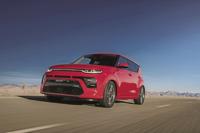
2021 Kia Soul
Saying a car looks like a box on wheels would not normally be a compliment. But in the case of the Kia Soul, it somehow works. This small SUV has a distinctive upright profile that stands out compared to more traditionally styled rivals. Kia also offers the Soul in different looks; GT-Line and Turbo trim levels offer red exterior accents and a mesh grille for a sporty theme, while the X-Line has gray fender cladding for more of an off-road vibe.
The Soul is easy to get in and out of and has plenty of room for passengers. The Soul also comes with a pleasing number of features for the money. For example, every Soul except the base LX comes with advanced driver safety aids that can help reduce driver distraction and mitigate imminent collisions.
Another bonus is Kia’s excellent five-year limited warranty. Negatives are few but include a bit too much wind and road noise on the highway.
Preferred pick: Soul S, $21,710
SPORTY SMALL HATCHBACK: 2021 Hyundai Veloster
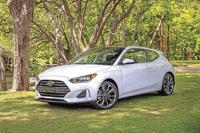
2021 Hyundai Veloster
Small but fun, the Hyundai Veloster is a unique pick because of its three-door layout. It has a single door on its driver’s side and two doors on its passenger side. This configuration creates a sporty, coupe-like appearance with the added benefit of an extra rear door to make it easier for rear passengers to get in and out.
The Veloster’s standard 147-horsepower engine is fine, but consider getting the available turbocharged engine. It makes a stout 201 horsepower and gives the Veloster quick acceleration. The extra power is also a pleasing complement to the Veloster’s sharp handling. Just like Kia, Hyundai offers a five-year limited warranty. On the downside, the Veloster’s ride quality is a little stiff, and the cabin can get noisy at highway speeds.
Preferred pick: Veloster Turbo R-Spec, $24,445
SENSIBLE MIDSIZE SEDAN: 2021 HONDA ACCORD
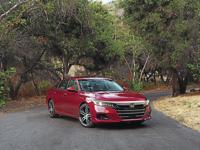
2021 Honda Accord
Few vehicles get closer to “no-brainer” pick status than the Accord. It’s consistently one of the top-selling cars in America, and the latest-generation Accord is one of Edmunds’ favorite midsize sedans. It’s roomy, upscale and enjoyable to drive. The Accord’s standard turbocharged engine provides pleasing power and above-average fuel economy. The Accord Hybrid is even more efficient, sipping fuel to the tune of 48 mpg in the EPA’s combined city/highway estimate.
Honda’s smaller Civic is a smart alternative to the Accord if you’re looking for a lower price. Going with the Accord, however, gets you a slightly bigger back seat and trunk. The interior is nicer, too, with more upscale materials. Infotainment and safety features on the Accord are abundant, though they’re not as simple to operate as those in some rival sedans. Our pick: Accord LX, $25,725
EFFICIENT MIDSIZE SUV: 2021 Toyota Venza
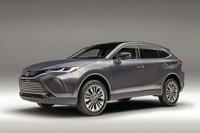
2021 Toyota Venza
Hybrids have a somewhat justified reputation for being a little dorky. Yet there’s nothing dorky about the new Venza. After a five-year hiatus, Toyota has taken this nameplate off the shelf for a 2021 midsize SUV fitted exclusively by a hybrid powertrain. This Venza has a sharp-looking exterior and a well-equipped cabin.
The Venza is good for an EPA-estimated 39 mpg in combined city/highway driving. This is among the highest estimates you can get from a hybrid SUV. All-wheel drive comes standard, too. As for negatives, the Venza’s cargo area isn’t as big as those in some other rival SUVs, such as the Ford Edge or Honda Passport. But if you want comfort, versatility and high fuel economy from your first vehicle, the Venza will work out great.
Preferred pick: Venza LE, $33,645
RELATED: 7 gas-saving tips that actually work
Get junk out of the trunk
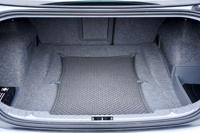
Car engineers spend a lot of time engineering pounds, ounces and grams out of today’s cars. Don’t undo their efforts (and the gas savings they represent) by leaving anything unnecessary in the luggage compartment. Golf clubs are a common violator, but so is random dead weight like those items slated to go to the second-hand store one of these days. Or, dear lord, a case of individual water bottles for after-workout hydration.
Every time you accelerate, you’re using gas to get that stuff up to speed with you. How much more? This depends on your car, but the EPA estimates a 1% reduction per 100 pounds. On a per-gallon cost basis, that’s about $0.03, using the EPA baseline figures. Get your stuff in order and you’ll save money, too.
Get the rack off the roof
When they’re not worrying about the weight of their designs, auto engineers fuss over aerodynamics. Improvements to how your car cuts through the air bear fruit most at high speeds — highway miles. The most common way drivers hurt their aerodynamics, and thus mileage, is by putting items on the roof.
Do you have activities that mandate a lot of equipment? Consider whether you could use a hitch-mounted rack or box instead. Tucked in the slipstream of your car, these have a much smaller mileage penalty. And, finally, if your vehicle came with a factory roof rack that you never use, see if you can remove the crossbars. You’ll save a few pounds this way, too.
Combine your trips
Being told to group your errands sounds a bit like a nag, much like the admonition not to use the trunk as a storage locker. Still, we will repeat the reasons why planning ahead can save gas:
If grouping trips means fewer miles driven, well, that’s obvious.
But even if you have to go in multiple directions, all non-electric cars use more fuel when the engine is cold. So the fewer times you to bring the engine up to temperature, the better. Cold starts aren’t good for your car (or the environment, for that matter).
Shut that puppy off
Americans continue to wildly overestimate how much fuel it takes to start an engine versus to keep it running. The reality is, once you’re stopped, your car is wasting fuel after about 7-10 seconds of idling. That’s why newer cars have a feature that shuts the engine off during stops when the brake is applied. The car’s still on, but the engine isn’t. Push the accelerator pedal and the engine snaps back on — off you go. Some people find this maddening, but the gas savings is real. If you want to maximize mileage, don’t disable the auto on-off feature.
Check apps and join clubs
Finding the cheapest fuel was once sport for me. But phone apps like Gas Buddy, Gas Guru and Fuelzee make it almost too easy to find the best gas deals. Since you can use them to screen for brands, you can also make sure you’re getting good quality fuel, which, in the long run, matters to the health of your car.
Joining a membership club like Costco or Sam’s Club could also pay off. Figuring how quickly you’ll recoup your membership cost with the per-gallon savings on their discounted fuel is pretty easy math.
Don’t rely on the tire light
All cars built since 2007 have tire-pressure monitoring systems. The hitch is this: The system might not alert you until a tire is 25% lower than the recommended pressure. And if you wait for that, you’re wasting money, as underinflated tires reduce your gas mileage by roughly 0.2% per pound that they’re low. That might not sound like much, but try this math: If your recommended inflation pressure is 40 psi, and you’re 25% low on air, that’s a 2% hit to your gas mileage. Plus, underinflated tires wear more quickly and unevenly, reducing your tire life.
Drive slowly wisely
No list of gas-saving tips would be complete without the admonition to slow down. There’s no getting around the fact that lower speeds require less fuel, most because aerodynamic resistance increases with the square of speed.
That’s the lecture. But driving to save fuel doesn’t have to be a dull crawl in the slow lane. Try thinking of it this way: brakes turn your money into heat, so can you avoid using them?
This isn’t meant to encourage dangerous behavior like not stopping for stop signs or the like. Rather, anticipate, anticipate, anticipate. Look down the road farther, and coast down when you know that traffic signal’s going to change to red. While hybrid and electric vehicles are best equipped to take advantage of this style (through regenerative braking), many conventional gas cars now engage power-sapping accessories like the alternator during coast-down to maximize fuel efficiency.
As for accelerating, if you know you’re going to be holding a higher speed for a while, like when you’re merging onto a highway, go ahead and shove the gas as hard as you need. Not only is slow acceleration in this situation potentially dangerous, it doesn’t actually save fuel.
Get local news delivered to your inbox!
"car" - Google News
November 27, 2020
https://ift.tt/2V7XN8N
Here are 4 vehicles that are great for first-time car owners - Napa Valley Register
"car" - Google News
https://ift.tt/2SUDZWE
https://ift.tt/3aT1Mvb
Bagikan Berita Ini














0 Response to "Here are 4 vehicles that are great for first-time car owners - Napa Valley Register"
Post a Comment